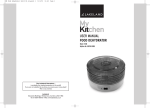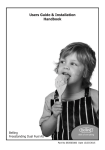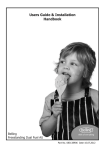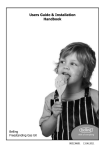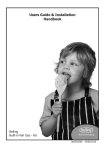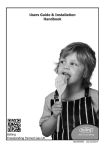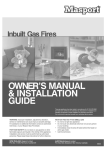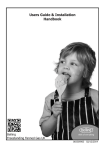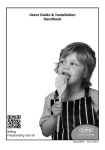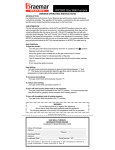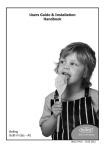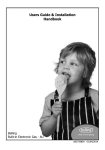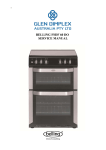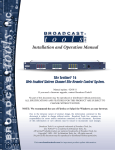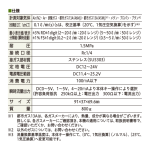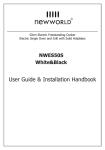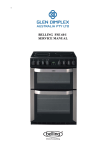Download User Manual
Transcript
Users Guide & Installation Handbook Belling Freestanding Fanned Gas AU Part No. 083180302 Date 26.07.2012 contents & OUR WARRANTY CONTENTS • INTRODUCTION • SAFETY • IGNITION PROCEDURE • USING THE HOB, GRILL AND OVEN(S) • HANDLING BAKING PROBLEMS If your appliance is covered by the warranty and guarantee, you will not be billed for work undertaken should your appliance be faulty. Terms and conditions do apply, so please read through the literature carefully. Please ensure that you have available your appliance’s model number and serial number. There is a space at the back of this book for recording that information. • RECOMMENDATIONS AND GOOD PRACTICES Important Notice • USING THE CLOCK PROGRAMMER/ MINUTE MINDER • cleaning • INSTALLATION INSTRUCTIONS • technical data • WIRING DIAGRAMS • CUSTOMER CARE INTRODUCTION Should you need it . . . . Inside the paperwork which has come with this appliance, there is a leaflet and card explaining the terms of our warranty and guarantee. Simply fill in the details on the card and post it off; this will register your appliance. Glen Dimplex Australia Unit 2, 205 Abbotts Road Dandenong South Victoria 31 75 Australia Ph: 1300 556 816 Fx: 1800 058 900 Glen Dimplex New Zealand Pty 38 Harris Road, East Tamaki Auckland New Zealand Ph: 09 274 8265 Fx: 09 274 8472 Please note there may be a cooling fan fitted to this appliance. It is an integral part of its safety and functionality. When the appliance is installed, care must be taken that the cooling fan’s performance is not impeded by any objects coming into contact with it, e.g. installation pipes, leads, etc. Care must also be taken that there is sufficient air flow at the rear of the appliance for the cooling fan to run at its optimum efficiency. See clearance dimensions in the installation section of this booklet. During use, the appliance must never be disconnected from the mains supply as this will seriously affect the safety and performance of the appliance. Surfaces may become too hot and gas operated parts may not work efficiently. The cooling fan is designed to run on after control knobs have been turned off. This helps to keep the front of the appliance and the controls within safe temperature limits. Safety Before Using the product Make sure that you have removed all packaging and wrapping. Some of the items inside this appliance may have additional wrapping. It is advised that you turn the ovens and/ or grill on for a short while. This will burn off any residues left from manufacturing. There may be a smell which accompanies this process - but this is nothing to worry about and is harmless. It is recommended that you wash the oven shelves, baking tray, grill pan and grill pan trivet before their first use in hot soapy water. This will remove the protective oil coating. Do not spray aerosols in the vicinity of this appliance while it is in operation. Do not use or store flammable materials in the appliance storage drawer or near this appliance. Do not modify this appliance. Oven / Grill Do • Always take care when removing food from the oven as the area around the cavity may be hot. • Always use oven gloves when handling any utensils that have been in the oven as they will be hot. • Warning! - Accessible parts may become hot during use. To avoid burns, young children should be kept away from the appliance. Always make sure that the oven shelves are resting in the correct position between two runners. Do not place the oven shelves on top of the highest runner, as this is not stable and can lead to spillage or injury. • Children should be supervised to ensure that they do not play with the appliance. This appliance is not intended for use by persons (including children) with reduced physical, sensory or mental capabilities, or lack of experience and knowledge unless they have been given supervision or instruction concerning use of the appliance by a person responsible for their safety. Always use the Minute Minder (if fitted) if you are leaving the oven unattended - this reduces the risk of food burning. Do Not Warning! - Servicing should be carried out only by authorised personnel. During use, the appliance must never be disconnected from the mains supply as this will seriously affect the safety and performance of the appliance. Surfaces may become too hot and gas operated parts may not work efficiently. The cooling fan is designed to run on after control knobs have been turned off. This helps to keep the front of the appliance and the controls within safe temperature limits. Caution: This appliance is for cooking purposes only. It must not be used for other purposes, for example room heating. General • Never place items on the door while it is open. • Never wrap foil around the oven shelves or allow foil to block the flue. • Never drape tea towels near the oven while it is on; this will cause a fire hazard. • Never pull heavy items, such as turkeys or large joints of meat, out from the oven on the shelf, as they may overbalance and fall. • Never use this appliance to heat anything other than food items and do not use it for heating the room. Safety Do Not Gas Hob • Never use double pans, rim-based pans, old or misshapen pans, or any pan that is not stable on a flat surface, including round bottomed woks, directly on top of the pan supports • Never leave cooking fat, or oil, unattended. • Never use commercial simmering aids, or heat diffusers, as they create excessive heat and can damage the surface of the hob. • Never use the hob for any other purpose than cooking food or raising the temperature of fluids. • Plastic cooking utensils can melt if they come into contact with a warm hob. Never leave them close to, or on top of the hob. • Never leave any heat zone alight without a pan covering it. This causes a fire hazard. • Never leave an empty pan on a heating zone. • Never leave anything lying on the hob. • Never heat a sealed tin of food, as it might explode. • Never use the hob surface for storage. Do • Always ensure that pan bases are dry and flat before using them on the hob. • Always position pans over the centre of the heat zone, and turn the handles to a safe position so they cannot be knocked or grabbed. • Always use pans which are no smaller than 100 mm (4”), or larger than 250 mm (10”) in diameter. • Limit the maximum flat based pan diameter to 230 mm (9”) above the wok burner, if two or more other hotplate burners are in use at the same time. • • Always match the size of pan to the heat zone – do not use large pans on small zones or vice versa. Always make sure that the burner caps, rings and pan supports are correctly placed. This will prevent pans becoming unstable while in use and ensure an uninterrupted gas flow. Important Ensure the wok burner skirt is positioned with the feature shown in the diagram below facing the front of the cooker. Failure to do this will cause the gas to burn incorrectly with an irregular flame pattern. ENSURE WOK BURNER SKIRT IS POSITIONED WITH FEATURE FACING THE FRONT OF THE COOKER. Safety Fire Safety Advice Most kitchen fires occur when people are distracted or leave things unattended. Don’t let yourself be distracted while cooking. If you’re called away from the cooker, either take pans off the heat, or switch off your hob. If you do have a fire in the kitchen, don’t take any risks - get everyone out of your home and call the Fire Brigade. If a pan catches fire: • Do not move it. It is likely to be extremely hot. • Turn off the heat if it is safe to do so but never lean over a pan to reach the controls. • If you have a fire blanket, put it over the pan. If you have put the fire out, leave the pan to cool completely. Deep-fat frying presents more dangers in your kitchen. • Never fill a chip pan (or other deepfat fryer) more than one-third full of oil. • Do not use a fire extinguisher on a pan of oil, the force of the extinguisher can spread the fire and create a fireball. If you have an electrical fire in the kitchen: • Pull the plug out, or switch off the power at the fuse box. This may be enough to stop the fire immediately. • Smother the fire with a fire blanket, or use a dry powder or carbon dioxide extinguisher. • Remember: never use water on a cooking oil or electrical fire. Ignition procedure Prior to ignition: Hotplate burner(s), position correctly sized, flat bottomed pan(s) directly onto the pan support above the selected burner(s). Wok burner (if fitted) a) Position a flat bottomed wok or a correctly sized, flat bottomed pan directly onto the pan support above the wok burner. b) Position the provided wok stand directly onto the pan support above the wok burner, then position a round bottomed wok directly onto the stand. Grill burner Open the grill door and position the grill pan into the selected runner position. Remove the pan handle and leave the door open. Oven burner(s) Ensure the oven shelves are positioned into the selected runner positions. Close the door(s). For main oven fanned gas cooking, push the convection fan button , prior to preheating for 15 minutes. Correct procedure for ignition of all burners on this appliance. Manual ignition (if applicable) • Push in and keep depressed the ignition button . Sparking to all gas burners will commence. • Push in and turn the selected gas burner control knob to the full flame symbol or for oven burners, the maximum temperature setting. Keep the control knob depressed. • As soon as the selected burner ignites release the ignition button. • Continue to hold the control knob in for up to 15 seconds then release. • If the burner fails to ignite within this time, release the control knob and wait 1 minute before attempting to re-ignite. Automatic ignition (if applicable) • Push in and turn the selected gas burner control knob to the full flame symbol . Keep the control knob depressed. Sparking to the selected burner will commence automatically. Sparking will cease automatically once the flame is established. • Continue to hold the control knob in for up to 15 seconds then release. • If the burner fails to ignite within this time, release the control knob and wait 1 minute before attempting to re-ignite. In the event of a power failure, or the ignition not working, then a lighted match or taper can be used to ignite the burner. Using the hob - gas • Use pans which are large enough to avoid overflows onto the hob surface. • Wipe any spillage as soon as possible. • Clean the hob top as regularly as possible, this will prevent any build up of grease which may be a fire hazard. Use • Place your pan onto the pan supports above the burner you wish to use. • Flat based woks may be positioned onto the pan support directly above the wok burner. • To ignite, see IGNITION PROCEDURE page. • To simmer, turn the control knob to the small flame symbol . This will ensure that the flame is just large enough to gently heat the contents of the pan. • To turn off, turn the control knob to the off position. • Always make sure that your pans are placed centrally on the burners and do not allow the flame to extend over the base of the pan. • • Energy Saving • Position pans centrally over the burners. • Only heat the amount of liquid you need. • Once liquids have been brought to the boil, reduce the heat setting to a simmer. • Consider using a pressure cooker if possible. • Vegetables cut into small pieces will cook more quickly. • Use a pan which is a close match to your burner size. • Smaller burners are ideal for simmering and stewing in smaller pans, while the larger burners are ideal for frying and boiling. Fold Down Lid (if fitted) Caution: Glass lids may shatter when heated. Turn off all the burners before shutting the lid. When opening and closing the lid, use the cooler outer sides of the lid glass. Avoid the use of pans that overhang The lid must be opened fully, so there is no danger of it closing while the hob is being used. the edges of the hotplate. The appliance is fitted with a safety system, which will automatically turn off the hotplate burners if they are inadvertently left on as the lid is closed. To use a round bottomed wok, position the wok stand provided onto the pan support above the wok burner, then position the wok onto the stand. The lid is not intended to be used as a work surface, as it becomes hot when any part of the cooker is in use. The surface may be scratched if items with rough or sharp surfaces are placed on it. Always remove any spillage from lid before opening. Always allow the hob surface to cool before closing the lid. Make sure that the wok stand is removed from the pan support before closing lid. using the grill - gas (if fitted) Caution: Accessible parts may be hot when the grill is used - young children should be kept away. Detachable grill pan handle To ignite, see IGNITION PROCEDURE page. The speed of grilling can be controlled by selecting a higher or lower shelf position. For toasting, and for grilling foods such as bacon, sausages or steaks, use a higher shelf position. For thicker foods such as chops or chicken joint pieces, use a middle to low shelf position. The grill trivet, inside the grill pan, can be inverted to give a high or low position, or it may be removed. Variation in grilling can be achieved by setting the control between the small and large flame symbols. Place the handle over the edge of the grill pan, at the narrow side edges. Slide the handle to the centre and locate between the handle position indicators. Important: Never operate the grill between the large flame and the ‘OFF’ position. To turn off, turn the control knob to the off position. Aluminium foil Using aluminium foil to cover the grill pan, or putting items wrapped in foil under the grill creates a fire hazard. The cooling fan (if fitted) The handle should be removed from the pan during grilling, to prevent overheating. The handle is designed for removing/inserting the grill pan under the grill when grilling. If cleaning the grill pan when it is hot, use oven gloves to move it. Do not use the handle to pour hot fats from the grill pan. Food for grilling should be positioned centrally on the trivet. Using the grill Important: The grill door must be fully open when the grill is used. Within a couple of minutes of the grill being turned on, the cooling fan will come on. This keeps the facia and control knobs cool during grilling. The fan will continue to operate after the grill has been turned off. During use the fan may cycle on and off, this is normal. USING THE GRILL - ELECTRIC (if fitted) Caution: Accessible parts may be hot when the grill is used - young children should be kept away. Detachable grill pan handle Using the grill Important: The grill door must be fully open when the grill is used. Open the grill door. Turn the grill control knob to the grill symbol position. For best cooking results, we recommend that you preheat the grill for about 3 minutes. Push the grill pan towards the back of the shelf, to position it under the grill. Place the handle over the edge of the grill pan, at the narrow side edges. Slide the handle to the centre, and locate between the handle position indicators. The speed of grilling can be controlled by selecting a higher or lower shelf position. For toasting, and for grilling foods such as bacon, sausages or steaks, use a higher shelf position. For thicker foods such as chops or chicken joint pieces, use a middle to low shelf position. The grill trivet, inside the grill pan, can be inverted to give a high or low position, or it may be removed. The HIGH trivet position is suitable for toasting bread. The LOW trivet position is suitable for grilling all types of meat & fish. With the grill trivet removed the food is placed directly on the base of the grill pan - eg: when cooking whole fish or browning dishes such as cauliflower cheese. The handle should be removed from the pan during grilling, to prevent overheating. The handle is designed for removing/inserting the grill pan under the grill when grilling. If cleaning the grill pan when it is hot, use oven gloves to move it. Do not use the handle to pour hot fats from the grill pan. Food for grilling should be positioned centrally on the trivet. To switch off, turn the control knob to the off position. Aluminium foil Using aluminium foil to cover the grill pan, or putting items wrapped in foil under the grill creates a fire hazard. The cooling fan (if fitted) When the grill is switched on, after a short delay, the cooling fan comes on to keep the fascia and control knobs cool during grilling. The fan may continue to operate for a period after the grill has been switched off. During use the fan may cycle on and off, this is normal. using the top oven - gas (if fitted) Using the top oven Ignition To ignite, see IGNITION PROCEDURE page. After igniting the oven burner, always turn the oven burner control knob to the maximum control knob setting and then turn down to the desired temperature setting. To turn off, turn the control knob to the off position. Using the top oven The top oven can be used in the same way as the main oven, to cook the full range of dishes, but it is a secondary oven and there are some differences. Foods cooked in the top oven should be in relation to the oven size. Larger dishes, or food which may rise during cooking, should be cooked in the main oven. Large items, wide tins and tall items such as rich fruit cakes should be cooked in the main oven to obtain optimum results. Notes: As part of the cooking process, hot air is expelled through a vent at the top of the oven(s). When opening the oven door, care should be taken to avoid any possible contact with potentially hot air, since this may cause discomfort to people with sensitive skin. To open the door, we recommend that you hold the underneath of the oven door handle. Preheating We recommend you always preheat the top oven for 15 minutes. If you are not preheating the oven, the cooking times in the baking guide may need to be extended, as they are based on a preheated oven. The oven must be preheated when reheating frozen or chilled foods, and we recommend preheating for yeast mixtures, batters, soufflés and whisked sponges. Put the oven shelves in the position required before preheating the oven. Zones of heat The temperature at the centre of the oven corresponds with the selected temperature setting and is slightly higher towards the top of the oven and slightly lower towards the oven base. The temperature at the oven base is suitable for cooking baked vegetables, baked fruit, milk pudding etc, and for warming bread rolls, soup, coffee, or ovenproof plates and dishes. If you find that over a period of time, the oven becomes hotter when used at a particular temperature setting, the thermostat may need to be replaced. using the top oven - gas (if fitted) Oven furniture Slow cooking (125°C) Baking tray and roasting tins Make sure that frozen foods are thoroughly thawed before cooking. For best cooked results and even browning, the maximum size baking trays and roasting tins that should be used are as follows; Baking tray 350 mm x 330 mm Roasting tin 370 mm x 320 mm Position baking trays and roasting tins on the middle of the shelves. For roasting small joints of meat or poultry, and for pot roasts preheat the oven to 190°C and cook for 30 minutes, then adjust the oven control to the 125°C setting for the remainder of the cooking time. Slow cooking times will be about three times as long as conventional cooking times. Oven shelves Extra shelves may be ordered from your local supplier. The oven shelf must be positioned with the upstand at the rear of the oven and facing upwards. The top oven shelf helps to ensure even baking in the top oven. It has a rear deflector fitted to it, and is not intended for use in the main oven. Oven light (if fitted) Press the oven light button on the facia panel. If there is no light button the oven light will come on automatically when the oven control is operated. Cook in oven at 180°C Approximate Cooking Time (preheated oven) Beef Rare Medium Well done 20 minutes per 450g (1lb), plus 20 minutes 25 minutes per 450g (1lb), plus 25 minutes 30 minutes per 450g (1lb), plus 30 minutes Lamb Medium Well Done 25 minutes per 450g (1lb), plus 25 minutes 30 minutes per 450g (1lb), plus 30 minutes Pork 35 minutes per 450g (1lb), plus 35 minutes Poultry 20 minutes per 450g (1lb), plus 20 minutes using the top oven - gas (if fitted) Top oven baking guide Food Recommended temperature (°C) Suggested Approximate shelf cooking time position (preheated oven) Scones 210 top - middle 10 - 15 mins Meringues 125 bottom 2 - 3 hours Small cakes 180 middle 15 - 25 mins Whisked sponge 180 middle 20 - 30 mins Swiss roll 195 middle 10 - 12 mins Victoria sandwich 165 middle 20 - 35 mins Cakes (2 x 180 mm / 7” per shelf) Genoese Sponge (side by side) 180 middle 25 - 30 mins Rough Puff 210 middle cooking time Flaky / Puff 195 middle depends on Shortcrust 195 middle recipe & type Flan 195 middle of filling Shortbread fingers 180 middle - top Nut brownies 180 middle Brandy snaps 165 middle - top Flapjacks 165 middle - top Ginger nuts 180 middle - top (2 x 180 mm / 7” per shelf) Pastry Biscuits Baking guide hints The temperature settings and times given in the baking guide are based on dishes made with block margarine. If tub margarine is used, it may be necessary to reduce the temperature setting. If a different temperature setting to that shown in our guide is given in a recipe, the recipe instruction should be followed. The cooking times given in the baking guides are based on a preheated oven. If you do not preheat the oven, cooking times should be extended. USING THE MAIN OVEN - conventional GAS Using the main oven To ignite, see IGNITION PROCEDURE page. After igniting the oven burner, always turn the oven burner control knob to the maximum control knob setting and then turn down to the desired temperature setting. To turn off, turn the control knob to the off position. Notes: As part of the cooking process, hot air is expelled through a vent at the top of the oven(s). When opening the oven door, care should be taken to avoid any possible contact with potentially hot air, since this may cause discomfort to people with sensitive skin. To open the door, we recommend that you hold the underneath of the oven door handle. Preheating Preheat the main oven for 15 minutes. If you are not preheating the oven, the cooking times in the baking guides may need to be extended, as they are based on a preheated oven. The oven must be preheated when reheating frozen or chilled foods, and we recommend preheating for yeast mixtures, batters, soufflés and whisked sponges. Put the oven shelves in the position required before preheating the oven. Zones of heat The temperature at the centre of the oven corresponds with the selected temperature setting and is slightly higher towards the top of the oven and slightly lower towards the oven base. These zones of heat can be useful as different dishes requiring different temperatures can be cooked at the same time, when more than one shelf is used. The temperature at the oven base is suitable for cooking baked vegetables, baked fruit, milk pudding etc, and for warming bread rolls, soup, coffee, or ovenproof plates and dishes. If you find that over a period of time, the oven becomes hotter when used at a particular temperature, the thermostat may need to be replaced. Oven light (if fitted) Press the oven light button on the facia panel. If there is no light button the oven light will come on when the oven control is operated. Oven furniture Baking tray and roasting tins For best cooked results and even browning, the maximum size baking trays and roasting tins that should be used are as follows; Baking tray 350mm x 330mm Roasting tin 370mm x 320mm Position baking trays and roasting tins on the middle of the shelves, and leave five clear shelf positions between shelves, to allow for circulation of heat. Oven shelves Extra shelves may be ordered from your local supplier. The oven shelf must be positioned with the up-stand at the rear of the oven and facing upwards. Slow cooking Make sure that frozen foods are thoroughly thawed before cooking. Do not slow cook joints of meat or poultry weighing more than 2¼kg/4½lb. Always use the top half of the oven for slow cooking. USING THE MAIN OVEN - CONVENTIONAL GAS For roasting joints of meat or poultry, and for pot roasts preheat the oven to 215°C and cook for 30 minutes, then adjust the oven control to 125°C for the remainder of the cooking time. Slow cooking times will be about three times as long as conventional cooking times. In conventional cooking mode, if 2 trays of scones were to be baked simultaneously, the upper tray would be ready for removal before the lower tray is complete. The lower tray should then replace the upper tray. Main oven baking guide Food Recommended temperature Suggested shelf position Approximate cooking time (preheated oven) (°C) Scones 230 middle - top 10 - 15 mins Meringues 125 bottom 2 - 3 hours 200 200 215 185 middle middle middle middle 185 170 170 150 or 160 middle middle middle middle - top 20 - 30 mins 1 - 1¼ hours 1 - 1¼ hours 2½ - 3 hours 150 or 160 bottom - middle 170 middle - bottom depending on recipe 2 - 2½ hours 230 215 215 215 middle middle middle middle - top top top top Cooking time depends on recipe and type of filling 200 185 185 185 middle middle middle middle - top top top top 25 10 20 10 Cakes Small cakes Whisked sponge Swiss roll Victoria sandwich (2 x 180mm/7”) Genoese sponge Madeira (180mm/7”) Gingerbread Semi rich fruit cake (205mm/8”) Christmas cake (205mm/8”) Dundee cake (205mm/8”) Pastry Rough Puff Flaky/Puff Shortcrust Flan Biscuits Nut brownies Brandy snaps Flapjacks Gingernuts - top top top top 15 20 10 20 - - 25 25 12 30 35 12 25 20 mins mins mins mins mins mins mins mins USING THE MAIN OVEN - CONVENTIONAL GAS Traditional fruit cakes Roast turkey It is necessary to test the cake before removal from the oven. Use a fine warmed skewer inserted into the centre of the cake. If the skewer comes out clean, then the cake is cooked. Roasting turkey involves cooking two different types of meat - the delicate light breast meat, which must not be allowed to dry out, and the darker leg meat, which takes longer to cook. • Do not attempt to make Christmas cakes larger than the oven can cope with, you should allow at least 25mm (1 inch) space between the oven walls and the tin. The turkey must be roasted long enough for the legs to cook, so frequent basting is necessary. The breast meat can be covered once browned. • Always follow the temperatures recommended in the recipe. • To protect a very rich fruit cake during cooking, tie 2 layers of brown paper around the tin. • We recommend that the cake tin is not stood on layers of brown paper, as this can hinder effective circulation of air. • Do not use soft tub margarine for rich fruit cakes, unless specified in the recipe. • Always use the correct size and shape of tin for the recipe quantities. • Always make sure that the turkey is completely thawed and that the giblets are removed before cooking. • Turkey should be roasted at 200°C for 20 minutes per 450g (1lb), plus 20 minutes, unless packaging advises otherwise. • The turkey can be open roasted, breast side down, for half of the cook time, and then turned over for the remainder of the cooking time. • If the turkey is stuffed, add 5 minutes per 450g (1lb) to the cooking time. • If roasting turkey covered with foil, add 5 minutes per 450g (1lb) to the cooking time. To test if the turkey is cooked, push a fine skewer into the thickest part of the thigh. If the juices run clear, the turkey is cooked. If the juices are still pink, the turkey will need a longer cooking time. USING THE MAIN OVEN - CONVENTIONAL GAS Roasting guide Notes: The times given in the roasting guide are only approximate, because the size and age of the bird will influence cooking times as will the shape of a joint and the proportion of the bone. • When cooking stuffed meat or poultry calculate the cooking time from the total weight of the meat plus the stuffing. • For joints cooked in foil or covered roasters, and for lidded casseroles, add 5 minutes per 450g (1lb) to the calculated cooking time. • Smaller joints weighing less than 1.25kg (2½lb) may require 5 minutes per 450g (1lb) extra cooking time. • Position the oven shelf so that the meat or poultry is in the centre of the oven. • It is recommended that the appliance is cleaned after open roasting. Frozen meat should be thoroughly thawed before cooking. For large joints it is advisable to thaw over night. Frozen poultry should be thoroughly thawed before cooking. The time required depends on the size of the bird - eg; a large turkey may take up to 48 hours to thaw. Use of a trivet with a roasting tin will reduce fat splashing and will help to keep the oven interior clean. Alternatively, to help reduce fat splashing, potatoes or other vegetables can be roasted around the meat/poultry. Cook in oven at 200°C Approximate Cooking Time (preheated oven) Beef Rare Medium Well done 20 minutes per 450g (1lb), plus 20 minutes 25 minutes per 450g (1lb), plus 25 minutes 30 minutes per 450g (1lb), plus 30 minutes Lamb Medium Well Done 25 minutes per 450g (1lb), plus 25 minutes 30 minutes per 450g (1lb), plus 30 minutes Pork 35 minutes per 450g (1lb), plus 35 minutes Poultry 20 minutes per 450g (1lb), plus 20 minutes USING THE MAIN OVEN - FANNED GAS Using the main oven Ensure the oven shelves are positioned into the selected runner positions. Close the door. For main oven fanned gas cooking, push the convection fan button , prior to preheating for 15 minutes. Ignition To ignite, see IGNITION PROCEDURE page. After igniting the oven burner, always turn the oven burner control knob to the maximum control knob setting and then turn down to the desired temperature setting. To turn off, turn the control knob to the off position. Press the convection fan button to stop the oven fan once cooking is complete. Preheating Preheat the main oven for 15 minutes. If you are not preheating the oven, the cooking times in the baking guides may need to be extended, as they are based on a preheated oven. The oven must be preheated when reheating frozen or chilled foods, and we recommend preheating for yeast mixtures, batters, soufflés and whisked sponges. Put the oven shelves in the position required before preheating the oven. Cooking with a fanned oven There are no zones of heat in a fan oven as the convection fan at the back of the oven ensures a more even temperature throughout the oven. This makes it ideal for batch baking – e.g. when preparing for a party - as all of the items will be cooked within the same period of time. When batch baking foods that will rise during cooking – e.g. bread – always ensure that enough space has been left between the shelves to allow for the rise. In order to maintain the free circulation of air within the oven, always leave at least 5 clear runner positions between trays. e.g. runner 9 runner 3 Notes: As part of the cooking process, hot air is expelled through a vent at the top of the oven(s). When opening the oven door, care should be taken to avoid any possible contact with potentially hot air, since this may cause discomfort to people with sensitive skin. To open the door, we recommend that you hold the underneath of the oven door handle. Oven light (if fitted) Press the oven light button on the facia panel. If there is no light button the oven light will come on when the oven control is operated. Main Oven Baking Guide Cooking times and temperatures The temperature settings and times given in the baking guide are based on dishes made with block margarine. If soft tub margarine is used it may be necessary to reduce the temperature setting. USING THE MAIN OVEN - FANNED GAS The following is intended as a guide and experience may show some slight variation to be necessary to meet individual requirements. Ovens were preheated for 15 minuets before testing. Food Forced fan oven Recommended temperature (° C) Oven Shelf position Time (minutes) Hard - individual 120 Any 90-180 Soft-Individual 190 Any 15-20 Pavlova - 6 egg 130 Any 75 Rolled 190 Any 10-15 Spooned 200 Any 12-15 Shortbread Biscuits 170 Any 30-35 Patty cakes 200 Any 15-20 Meringues Biscuits Cakes Sponge - 4 egg 190 Any 20-30 Plain Butter Cake 190 Any 25-40 Rich Fruit Cake 150 Any 180 230 Any 10-15 Cornish Pasties # 210 then 190 Any 10 then 30 Custard Tart # 230 then 190 Any 10 then 35 220 Any 25-30 220 Any 25-30 Scones Plain or fruit Pastry - Shortcrust Pastry Choux Cream Puffs Yeast Goods Bread * Shelf positions are counted from the bottom runner up. Bottom shelf position is runner 1. Top shelf position is runner 10. #Turn down temperature shown. USING THE MAIN OVEN - FANNED GAS Cook in oven at 200°C Approximate Cooking Time (preheated oven) Beef Rare Medium Well done 20 minutes per 450g (1lb), plus 20 minutes 25 minutes per 450g (1lb), plus 25 minutes 30 minutes per 450g (1lb), plus 30 minutes Lamb Medium Well Done 25 minutes per 450g (1lb), plus 25 minutes 30 minutes per 450g (1lb), plus 30 minutes Pork 35 minutes per 450g (1lb), plus 35 minutes Poultry 20 minutes per 450g (1lb), plus 20 minutes HANDLING BAKING PROBLEMS Problem Causes Uneven cooking • Oven not preheated adequately • Preheat oven to instructions • Incorrect shelf position • Refer to oven cooking guide • Baking tray or dish incorrect colour • Electric - silver or shiny Gas - Dark Coloured • Oven tray too large • Try other trays or dishes • Trays not in centre of shelf • Put trays in centre of shelf • Air flow in oven uneven • Turn food during cooking • Oven not preheated • Preheat until indicator light goes off for electric & at least 15 minutes for gas • Aluminum foil in oven • Remove foil • Baking tins too large for recipe • Use correct size tins • Baking tins not evenly spaced • Place baking tins so that there is at least 3 cms between tins and oven walls • Food not evenly sized or placed on trays • Make food same size and shape and spread evenly on trays • Food placed too close to top of oven • Place food in middle or on a lower shelf • Baking temperature too high • Lower temperature • Baking tins too large for recipe • Use correct size tins • Baking tins are dark metal or glass • Change to Shiny, light tins or lower temperature by 10°C • Food too low in oven • Cook two shelves higher • Oven door opened too frequently during cooking • Do not open door until half way through cooking time Baked products too brown on top Baked products too brown on bottom What to do HANDLING BAKING PROBLEMS Problem Causes Cakes have cracked thick crust • Baking temperature too high • Lower temperature • Food too high in oven • Cook two shelves lower • Cake batter over mixed • Mix just long enough to combine ingredients • Pan too deep • Check size of pan and use recommended size • Baking tins too dark • Change to shiny tins • Baking temperature too low • Raise temperature • Food too low or high in oven • Cook two shelves higher for gas or lower for electric • Baking time too short • Increase cooking time • Incorrect tin size • Use correct size tin • Baking temperature too low • Raise temperature • Baking time too short • Increase cooking time • Measurement of ingredients is wrong • Check recipe • Door opened too early • Do not open door until at least three quarters (3/4) of the way through cooking time or switch on oven light and view through door glass Crusts too thick • Incorrect ingredients • Check recipe Meat and potatoes not browning in fan oven • Poor circulation • Put food onto a rack to allow air to circulate properly. • Do not pierce meat with fork but turn with tongs Baking products are pale, flat and undercooked Cakes fallen in centre Juices running out of meat What to do RECOMMENDATIONS AND GOOD PRACTICES • After igniting the oven burner, always turn the oven burner control knob to the maximum control knob setting and then turn down to the desired temperature setting. • After preheating the oven for 15 minutes at the selected temperature, open the door and enter the food as quickly as possible to minimise heat losses. • Close oven door gently so as not to disturb the position of foods or cause unnecessary disturbance to the oven flame. • Whenever possible press the oven light button to assist viewing the cooking progress, rather than opening the door to view food. • Do not leave the oven light on continuously during the cooking process, this wastes energy and costs you more. • To prevent the build up of unburnt gas, push in and keep depressed the ignition button before you push in and turn the burner control knob to the large flame symbol . This is particularly useful for the enclosed oven burner(s) and also the wok burner, when a pan is positioned above it. • Certain dishes can leave lingering odours in an oven, which can taint the taste of the next food cooked or baked. To prevent this, after cooking a particularly odorous dish, e.g. fatty lamb, allow the oven to cool, open the oven door, wipe up any obvious spills and splashes from the oven interior, then push the oven convection fan button and allow the fan to operate for awhile, to help force out the odours. • Always remember to switch the oven convection fan off after use. Do not waste energy. using the clock programmer-GAS (IF FITTED) The ‘function’ button in the centre is used for setting the minute minder and setting up the automatic cooking. See below for details. To set the time of day When the power is turned on to the appliance, the time of day starts from 0.00. Press and release the (minus) and (plus) buttons simultaneously. Set the time of day, eg 2.00 with the and buttons while the ‘dot’ between the hours and minutes is flashing. To select an alarm tone Press and hold the (minus) button to listen to the first tone. Release the button and press it again to listen to the second tone, etc. Releasing the button after the tone has sounded will automatically select that tone. Setting the minute minder Press and release the function button. The minute minder bell symbol will appear and flash on the display. Use the plus and minus buttons to set the required alarm time. After setting, the display will revert to show the time of day and the bell symbol will stop flashing. Pressing the function button will display the minutes remaining. If the time has counted down to the last minute, the remaining seconds are shown. The tone will sound at the end of the time set. To cancel the tone, press the function button. Semi-automatic cooking This clock function can be used when you have started cooking a meal or a dish in the oven and want to set the time for the oven to switch off. Press and release the function button twice. The display will show the oven symbol flashing and also the A (auto) symbol is shown. Use the plus and minus buttons to set the display to show the length of cooking time required (eg, 2 hours *). After setting, the display will revert to show the time of day and the oven and auto symbols will be shown in the display. The function button can be pressed and released twice to show how much cooking time remains on the clock. At the end of the cooking time, the alarm will sound and the oven will automatically switch off. To switch off the alarm, press the function button. If you wish to cancel the remaining cooking time on the clock before the alarm sounds, press the minus button until the display returns to 0.00. NOTE - the minute minder function can be used independently from other timer functions. Eg. it is still possible to use the minute minder facility during a semi automatic cooking function. When both programs are running simultaneously, both the semi automatic indicator A, and oven symbol will be displayed alongside the minute minder bell indicator in the time of day display. * As shown using the Minute minder (if fitted) Electronic minute minder The digital timer enables you to set the time of day (24 hour clock) and the minute minder alarm. Setting the “Time of Day” • Switch on the electricity supply to the appliance. • The display will flash. • Press and release the time of day button. • Set the time of day with the plus and minus buttons. • The time will be set 7 seconds after the last plus or minus operation. Alarm tones After setting the time of day, you can select one of three alarm tones. Press the minus button to listen to the first tone, then release the minus button and press it again to listen to the second tone, etc. Releasing the minus button after a tone has sounded will automatically select that tone. Setting the minute minder • Press and release the plus button to change the display from clock to minute minder - the bell symbol will light. • Use the plus and minus buttons to set the length of time before the alarm tone will sound. The display will increase/decrease in units of 10 seconds up to 99 minutes 50 seconds, and in units of 1 minute from 1 hour 40 minutes upwards. The maximum period which may be set is 10 hours. The display format will change after 99 minutes and 50 seconds to 1 hour and 40 minutes. During countdown, the minute minder has priority on the display, which will show (in minutes : seconds, or hours : minutes) the time remaining. When countdown is complete, the tone will sound for 7 minutes, or it can be reset with one touch of any button. To cancel the minute minder at any other time, run down the set time with the minus button. The display will revert to show the time of day. Mechanical minute minder Turn the minute minder control knob fully to the maximum setting, then turn back to the desired setting. When countdown is complete, the timer will give a audible signal for a few seconds before it stops. cleaning General • It is important to clean the product regularly as a build up of fat can affect its performance or damage it and may invalidate your guarantee. • Always switch off your appliance and allow it to cool down before you clean any part of it. • Do not use undiluted bleaches, products containing chlorides, wire wool or abrasive cleaners on aluminium, stainless steel, or plastic/ painted parts as they can damage the appliance. Nylon pads can also be unsuitable. • Take extra care when cleaning over symbols on fascia panels. Excessive cleaning can lead to the symbols fading. • If your product is fitted with stainless steel cladded strips. You may notice a small white residue on the outer edges, this can be removed with a non abrasive wipe. • Do not use steam cleaners. Some foods are corrosive eg; vinegar, fruit juices and especially salt - they can mark or damage the metal if they are left on the surface. • Baby oil can be used to restore stainless steel finishes - but only use a few drops. Don’t use cooking oils as they can contain salts, which will damage the metal. Enamel surfaces & parts • Clean with warm, soapy water and a clean cloth. • If larger splashes of fat do not readily disappear, you can use a mild cream cleaner to remove them. More stubborn marks can be removed using a soap filled pad. • Rinse well and dry with a soft clean towel or cloth. • Do not use steam cleaners. Glass parts • Only use a clean cloth wrung out in hot soapy water, or a specialist glass cleaner. Painted & Plastic parts • Only use a clean cloth wrung out in hot soapy water. • Rinse away any excess cleaner and dry with a soft cloth. • Do not use abrasive cleaners, wire or nylon cleaning pads on these parts. • Do not use abrasives or polishes as they will scratch and damage the glass. Stainless steel & Aluminium surfaces • Only use a clean cloth wrung out in hot soapy water, and dry with a soft cloth. • Stubborn marks can be removed using a stainless steel cleaner. Supplies can be purchased from the Customer Care Centre. • Sharp objects can mark the surface of stainless steel, but will become less noticeable with time. • Wipe any spillage immediately, taking care to avoid burning your hands- Chrome plated parts • Use a moist soap filled pad, or place in a dishwasher Cleaning Removing Oven Parts For Cleaning Inner Door Glass • The inner door glass panel can be removed for cleaning but it must be replaced the right way up. If there is any writing on the glass, you must be able to read it clearly when the cavity doors are open. • Always make sure that the glass is pushed fully into the Stop position. • To remove the glass panel, open the door wide, hold the top and bottom edges and slide out. • Warning: do not operate the appliance without the glass panel correctly fitted. • For your safety, glass door panels are made of toughened glass. This ensures that, in the unlikely event that a panel breaks, it does so into small fragments to minimise the risk of injury. Please take care when handling, using or cleaning all glass panels, as any damage to the surfaces or edges may result in the glass breaking without warning or apparent cause at a later date. Should any glass panel be damaged, we strongly recommend that it is replaced immediately. • Do not use harsh abrasive cleaners or sharp metal scrapers to clean the oven door glass since they can scratch the surface, which may result in shattering of the glass. Shelf Runners • Shelf runners can be removed to enable you to clean them thoroughly. Make sure they are cool to touch and then grasp the runners and slide out of their hanging holes. PULL OUT TO CLEAN Cleaning Cast iron griddle or pan supports (if fitted) Gas Hob Burner caps and heads • The slots in the burner head where the flames burn should be cleared of deposits. • Clean with a nylon brush, rinse and then dry thoroughly. There may be brown coloured markings on your burners; these are carbon deposits or fat stains and can be removed using a soap filled pad. • Do not put burners in the dishwasher or soak them. Using dishwasher powders, washing up liquids and caustic pastes can damage the burners. • Burner caps and heads must be repositioned correctly so that they sit squarely on to the hob as shown. This is particularly important with stainless steel models as failure to reposition the caps correctly may result in discolouration of the stainless steel around the burners. burner cap correct parallel burner head incorrect angled burner cap not central incorrect • Ensure the griddle has fully cooled and scrape off any stubborn marks and bits of food with a plastic or wooden cooking implement. Rinse in warm soapy water and dry with a tea towel. • Do not clean in a dishwasher. • If you notice any rusting on your griddle, or pan-supports, simply clean in warm soapy water, then re-season. • To season: Heat the griddle for 30 seconds at a medium setting then switch off. Use a minimum amount of unsalted vegetable oil, on a dry cloth or paper towel, and apply a thin coat of oil to the element surface. Wipe off the excess and re-heat the griddle for one minute. installation instructions - gas Before you start: Please read the instructions. Planning your installation will save you time and effort. Prior to installation, ensure that the local distribution conditions (nature of the gas and gas pressure) and the adjustment of the appliance are compatible. The adjustment conditions are stated on the data badge. This appliance is not connected to a combustion evacuation device. It shall be installed and connected in accordance with current installation regulation. Particular attention shall be given to the relevant requirements regarding ventilation. The information below is crucial to installing this appliance correctly and safely. Gas Safety (Installation & Use) Regulations This appliance must by an authorised person in accordance with the Australian Gas Installation Standard AS5601 the manufacturers installation instructions, local gas fitting regulations, and any other relevant statutory regulations. Particular attention should be given to relevant requirements regarding ventilation. Failure to install appliances correctly is dangerous and could lead to prosecution. Ventilation Requirements Ventilation must be as specified by AS 5601 Installation code. The room containing the appliance should have an air supply. An appliance should be installed in a location for complete combustion of gas, proper flueing and to maintain ambient temperature of the immediate surrounding at safe limits, under normal conditions. Failure to install appliances correctly is dangerous and could lead to prosecution. Warning - This appliance is unsuitable for use in a marine environment. If the appliance is placed on a base, measures have to be taken to prevent it slipping from the base. Caution - The use of gas cooking appliance results in the production of heat, moisture and products of combustion in the room in which it was installed. Ensure that the kitchen is well ventilated especially when the appliance is in use: keep natural ventilation holes open or install a mechanical ventilation device (mechanical extractor hood). installation instructions - gas Windows and permanent vents should therefore not be blocked or removed without first consulting a competent gas installer. Failure to install appliances correctly is dangerous and could lead to prosecution. Whilst every care is taken to eliminate burrs and raw edges from this product, please take care when handling - we recommend the use of protective gloves during installation. Moving the cooker Please note that the weight of this appliance is approximately 60kg (unpacked). Take care if the appliance needs to be lifted during installation - always use an appropriate method of lifting. Do not attempt to move the cooker by pulling on the doors or handles. Open the door and grasp the frame of the cooker, taking care that the door does not shut on your fingers. Take care to avoid damage to soft or uneven floor coverings when moving the appliance. Some cushioned vinyl floor coverings may not be designed to withstand sliding appliances without marking or damage. Clearances & dimensions Appliance dimensions All sizes are nominal - some variation is to be expected. The ‘depth’ of the cooker, as given below, is to the front of the door & excluding knobs & handles. depth: 600mm width: 549mm or 600mm height - lid down: 900 - 915mm height - lid raised:1430 -1445mm Clearances No shelf or overhang or cooker hood should be closer than a minimum of 650mm, but check with cooker hood manufacturer’s recommendations. The cooker must have a side clearance above hob level of 90mm up to a height of 400mm. Cookers with drop-down main oven doors may be fitted flush to base units. However, for models with side opening doors, we recommend a side clearance of 30mm between the cooker and any side wall adjacent to the hinged side of the doors. 90 mm 90 mm 650 mm 400 mm 400 mm installation instructions - gas Levelling Your Cooker Place a spirit level on a baking sheet onto an oven shelf. The cooker is fitted with LEVELLING FEET (1). Level your cooker to your desired height using the levelling feet at the front and rear of the cooker. A minimum clearance of 15mm is essential for clean air supply. Place the cooker in position and draw a PENCIL LINE level with the front edge (2). Mark the centre of the cooker to give a CENTRE LINE (3). Remove the cooker and mark off 200mm to the right of the centre line (4) on the rear wall. Measure from FLOOR LEVEL to the ENGAGEMENT EDGE where the stability bracket will rest and add 2mm (5). Transfer this dimension to the rear wall and secure the bracket to the wall at this height (6) using the two off centre holes in the single bracket. Stability bracket The stability bracket provided must be fitted to the back of the cooker and fitted as follows: installation instructions - gas Connect to the gas supply Means of isolation shall be provided at the shut off point by either an approved quick connect device or a Type 1 manual shut off valve. The outlet of the quick connect device shall be at, or below, the horizontal position. oven flue tubes on the rear of the appliance. Use a 900mm - 1200mm length of flexible connector. Ensure that all pipework is of the correct rating for both size and temperature. Natural Gas- Installations must conform to local codes or, in the absence of local codes with AS:5601 as well as the requirements of any local council, gas, electricity authority or other statutory regulation. After installation, make sure all connections are gas sound. Connect to the electricity supply - Gas (mains ignition models only) Connection to the gas supply should be made using the Aquaknect AS/NZS 1869 class B hose assembly with an internal diameter of not less than 10mm and regulator (regulator for use with natural gas). For operation on NG The appliance regulator provided must be oriented so that the pressure nipple (on the outlet) is accessible. The governor must be fitted to the supply line. Warning: This appliance must be earthed. The flexible mains lead is supplied connected to a mains plug which complies with AS/NZS 3112. Replace only with a plug of the same type and rating. WIRING SIDE OF THE PLUG For operation on LPG (propane). The pressure test point fitting provided must be fitted to the supply line. NOTE: The temperature rise of the areas at the rear of the cooker that are likely to come into contact with the flexible hose do not exceed 70˙C. The inlet to the cooker is ½” BSP internal situated at the rear right corner. Fit the bayonet connection. This should be located so as to ensure that the flexible connector hose does not kink. Under no circumstances should the flexible connector be allowed to come into contact with the vertical 1. The wire which is coloured green and yellow must be connected to the terminal marked E (Earth) or coloured Green. 2. The wire which is coloured blue must be connected to the terminal marked N (Neutral), or coloured Black. installation instructions - gas 3. The wire which is coloured brown must be connected to the terminal marked A(Active/Live), or coloured Red. The plug and socket must be accessible after installation. Should the mains lead of the appliance ever require replacing, this must be carried out by a qualified electrician who will replace it with a lead of the same size and temperature rating. Important: - ensure that you route all mains and electrical cables and flexible tubing well clear of any adjacent heat source. Under no circumstances should the mains electric cable be allowed to come into contact with the vertical oven flue tubes on the rear of the appliance. Checking the gas supply Check the manometer zero point is correct. Connect the manometer to the cooker pressure test point. Turn on the gas supply and the electricity then try to ignite the gas. ously at the full on setting. b) When the smallest burner of the appliance is operating at the low setting. Under these conditions the outlet pressure should be between 0.8 kPa and 1.2 kPa. Commissioning Burner aeration All burners have fixed aeration and no adjustment is possible. Check the ignition of all burners both separately and in combination. see IGNITION PROCEDURE page as described earlier in this booklet. Check the operation of electrical components, viz; Clock programmer/ Minute minder Check functions as described earlier in this booklet. Oven light Note: It will take additional time to light the gas for the first time as air needs to be purged from the pipes. Push the light button for ON, push button again for OFF. Check the operating pressure for the particular gas types. NG 1.00 kPa, LPG 2.75 kPa Open the oven door, push the fan button, look into the oven and check fan is ON, push button again for OFF. For LPG cookers Cooling fan Adjust the regulator if necessary (this may be remote from the cooker). Open the grill door. Ignite the grill burner and check that the cooling fan switches on within approx. 2 minutes. As soon as the cooling fan switches on, turn off the grill control knob and check that the fan switches off within approx. 2 minutes. For NG cookers Regulators are supplied pre-adjusted and configured by the component maker for use with Natural Gas. The appliance installer should not be required to make an adjustment to obtain the correct outlet pressure setting. Regulator outlet pressure should be checked when a) All burners are operating simultane- Oven convection fan Lid safety system Ignite all hotplate burners including wok. Attempt to close the lid and make sure all flames are extinguished by the safety system. installation instructions - gas If you are satisfied that the cooker is operating correctly, turn it off and show the customer how to use it. Make sure you ask the customer to operate the clock (if fitted) and controls. Explain to the user that the lid safety system must not be used as a means of turning off the hotplate burners. Control knobs must always be turned to the ‘OFF’ position after use. Note- If the cooker does not perform correctly, inform the customer of the problem and put a warning notice on the cooker. If the problem is dangerous, then disconnect the cooker. If there is a fault, then the customer should be advised to contact the manufacturer’s local service organisation or the retailer. Before leaving the installation hand over the handbook to the customer. Thank you. TECHNICAL DATA Type of gas: Please see data badge for your specified gas type. Injectors used (0.01mm) Natural Gas LP Gas Never attempt to convert an appliance unless the data badge states that you can. Small 82 50 Medium 118 70 Burner Aeration: Wok 185 104 Grill 140 Amal 83 Fixed Pressure setting: Natural Gas - 1.0 kPa Propane - 2.75 kPa Top oven 115 72 Electrical supply: 240V ~ 50Hz Main oven 144 82 Power @ 240v BEL FSG 60 TCF 51W BEL FSG 60 DOFP 1900W Countries of destination: AU, NZ Data - Oven and Grill Products FSG54TCF AU / FSG60TCF AU Fuel Type Hotplate Burner /Element Nominal Rate Qn Natural Gas Hob - small Hob - medium x 2 Hob - Wok Grill Main oven 3.45MJ/h 6.90MJ/h 14.40MJ/h 9.40MJ/h 9.00MJ/h Total heat input 50.05MJ/h Hob - small Hob - medium x 2 Hob - Wok Grill Main oven 3.45MJ/h 6.90MJ/h 14.40MJ/h 9.40MJ/h 8.60MJ/h Total heat input 49.65MJ/h LP Gas FSG60DOFP AU Fuel Type Hotplate Burner /Element Nominal Rate Qn Natural Gas Hob - small Hob - medium x 2 Hob - Wok Top oven Main oven 3.45MJ/h 6.90MJ/h 14.40MJ/h 6.35MJ/h 9.00MJ/h Total heat input 47.00MJ/h Hob - small Hob - medium x 2 Hob - Wok Top oven Main oven 3.45MJ/h 6.90MJ/h 14.40MJ/h 6.35MJ/h 8.60MJ/h Total heat input 46.60MJ/h LP Gas WIRING DIAGRAM BELLING FSG 54TCF-AU WIRING DIAGRAM Wiring colour code: Bk - Black, Bn - Brown, Bu - Blue, Gn - Green,Or - Orange, R - Red, W - White, Y - Yellow. STIR FAN SWITCH R IGNITION SWITCH Bn Bk Bn Bn LIGHT SWITCH F50c THERMAL OVERRUN SWITCH Bn R W Bu OVEN STIR FAN COOLING FAN Bu Y Bu Bu Bn Bn MAIN OVEN LAMP IF FITTED Bu Bn Gn MOUNTING PLATE L Bu Bk Y Gn N SW SW IGNITION GENERATOR IGNITION ELECTRODES Issue B 10/07/2012 WIRING DIAGRAM BELLING FSG 60TCF-AU WIRING DIAGRAM Wiring colour code: Bk - Black, Bn - Brown, Bu - Blue, Gn - Green, Or - Orange, R - Red, W - White, Y - Yellow. MINUTE MINDER STIR FAN SWITCH L R N W Bn LIGHT SWITCH Bk Bn F50c THERMAL OVERRUN SWITCH Bn Bk IGNITION SWITCH Bn W COOLING FAN OVEN STIR FAN Bu R Y Bu Bn Bn MAIN OVEN LAMP IF FITTED Bu Bn Bu L Gn Bk Y Gn N SW SW IGNITION GENERATOR MOUNTING PLATE IGNITION ELECTRODES Issue C 10/07/2012 WIRING DIAGRAM BELLING FSG 60DOFP-AU WIRING DIAGRAM Wiring colour code: Bk - Black, Bn - Brown, Bu - Blue, Gn - Green, Or - Orange, R - Red, W - White, Y - Yellow. THERMOSTAT 08-3008800 PROGRAMMER EARTH POINT INNER FASCIA Bn STIR FAN SWITCH NC R NO Bn W Bn Bn LIGHT SWITCH F60c THERMAL OVERRUN SWITCH R Bk Bk R Bn COOLING FAN OVEN STIR FAN C GRILL T/OVEN MICROSWITCH W IGNITION SWITCH Bu Y Bu R L120c THERMAL CUTOUT Bn Bn Bu MAIN OVEN LAMP W IF FITTED Bu Bn Bu W Bk Y R Gn Gn L Gn N SW SW IGNITION GENERATOR MOUNTING PLATE GRILL ELEMENT IGNITION ELECTRODES ISSUE C: 10/07/2012 customer care FAQs What parts of the appliance can be washed in a dishwasher? • Any enamelled parts such as the grill pan can be cleaned in a dishwasher, as can oven shelves and shelf guides. duce condensation when the oven is cooling down with food inside. Should the cooling fan continue to run once the appliance has been switched off? • What parts must NOT be cleaned in a dishwasher? • Parts such as burner skirts and caps, control knobs and any cast iron items must not be cleaned in a dishwasher, they should be cleaned with hot soapy water and a nylon brush once they are cool enough. Can all gas appliances be converted from Natural Gas to LP Gas? • There’s been a power failure and the product won’t work. • Switch off the electricity supply. • When the power returns switch the electricity supply back on and re-set any programmer/clock to the correct time of day. No. You can only use one or the other. Why is there condensation on the doors? • Condensation is caused by hot, moist air meeting a cooler surface (i.e. the oven door). You cannot always prevent it, but you can minimise it when it happens by doing the following: • Preheat the oven at a high temperature before putting food in the oven, and cover the food you are cooking wherever possible. • Whenever you can, cook wet foods at higher temperatures. • Don’t leave food in the oven to cool down. • Automatic cooking will normally pro- Not all gas appliances can be converted. If Category II is stated on the databadge, then the appliance may be converted and a conversion kit must be obtained if not already provided. If in doubt, please contact Customer Care for further advice - do not attempt to convert an appliance if it is not compatible. Why won’t the ignition work? • My oven is a single combined oven and grill - can I use both functions together? • Yes. This is to make sure that you can always touch the control knobs to make temperature adjustments, and turn your appliance off. Check there is a spark when the ignition button is depressed. If there is no spark, check the electricity supply is switched on at the socket. Check that the gas supply is switched on. Call Customer Care for a Service Engineer’s visit if: • You find that the oven becomes hotter at a particular temperature - the thermostat may need replacing. • The cooling fan fails to work. customer care CHANGING LIGHT BULBS (where fitted) Bulbs can be purchased from hardware stores (always take the old bulb with you). Warning: There is a risk of electric shock, so always make sure you have turned off and unplugged your appliance before starting. Always allow the product to cool down before you change a bulb. Please remember that bulbs are not covered by your warranty. Not all appliances have the same number and type of bulbs. Before replacing your bulb, open the oven door and see which type you have. Then use the table to help you change your bulb correctly. No of Lamps Bulb location Oven Type Instructions 2 Side All Remove the oven shelves. Grasp the lens cover on the light fitting and pull it away from the side of the oven. Unscrew the bulb and replace. Replace the lens cover 1 Rear Fanned/Multifunction Remove the oven shelves. Remove the loose oven back (Electric) by unscrewing the 4 securing screws (one at each corner) and remove. Unscrew the lens cover by turning anticlockwise. Remove the bulb and replace. Replace the lens cover and oven back. 1 Rear Conventional/Fanned Remove the oven shelves. Unscrew the lens cover by turning (Gas) anticlockwise. Remove the bulb and replace. Replace the lens cover. Please keep this handbook for future reference, or for anyone else who may use the appliance. Please keep this handbook for future reference, or for anyone else who may use the appliance. Please keep this handbook for future reference, or for anyone else who may use the appliance. Please keep this handbook for future reference, or for anyone else who may use the appliance. CONTACT US Calling for a service If you should experience any problems with your cooker please contact your retailer or place of purchase. Important note: Service work is to be conducted by authorised persons only. It is advisable to have your cooker checked regularly and maintained in good condition. An annual maintenance is recommended. Always check the instruction book before calling a service agent to make sure you have not missed anything. Glen Dimplex Australia Pty Ltd Customer Care: Tel: Australia 1-300-556-816 New Zealand 09-274-8265 Before you contact a service agent, make sure that you have the following information to hand: Model Number Serial Number Date of Purchase Postcode Glen Dimplex Australia, Unit 2, 205 Abbotts Road, Dandenong, South Victoria 3175, Australia e-mail: [email protected] web: www.glendimplex.com.au












































